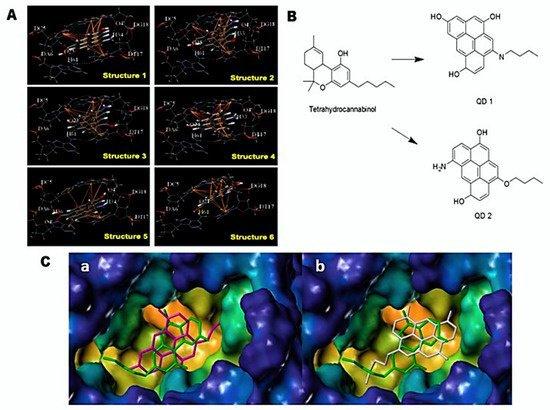UTEP researchers help bring biofriendly materials to drug design for neuro disorders

The contributions of researchers from The University of Texas at El Paso have yielded the first indication that carbon quantum dots, a class of nanoparticles, can be utilized to combat neurological disorders. Credit: Mahesh Narayan
The study, titled “Untangling the Potential of Carbon Quantum Dots in Neurodegenerative Disease,” was co-authored by Sreeprasad T. Sreenivasan, Ph.D., and Mahesh Narayan, Ph.D., assistant professor and professor, respectively, in UTEP's Department of Chemistry and Biochemistry.
The pair contributed to work by Prakash Narayan, Ph.D., vice president of preclinical research for Angion Biomedica Corp. in Uniondale, New York; and Lindsey Jung, a student at Tenafly High School in New Jersey, who works under Prakash Narayan's supervision.
The study focuses on carbon quantum dots (CQDs), biofriendly materials synthesized from waste materials such as wood, fruit peel, algae and even salmon.
A road map laid out by the research team addresses, for the first time, key requirements for the transitioning of their use from environmental-sensing applications into the neurodegenerative domain; a crossing-over that requires their separation and total characterization, including aspects related to safety and their ability to target specific receptors in the brain.
“The carbonaceous quanta are finally making their way from physics into chemistry and now, biology,” Prakash Narayan said. “This work lays the foundation for harnessing the enormous potential of carbon quantum dots for therapeutic intervention in neuro disease.”
The CQDs are made by “pressure-cooking” waste biomaterials such as fruit peel, amino acids, algae and even fish. As an outcome of the procedure, they are synthesized as a mixture of carbon dots and non-carbon dots. Some of the compounds in the mixture can be toxic. This aspect would negate their use in biomedical applications.
To facilitate the crossing-over of CQDs into preclinical and eventually clinical use, the research team provides a path for their safe use while demonstrating their potential to both prevent and treat neurodegenerative disorders, Mahesh Narayan said.
The research was conducted at Angion Biomedica, and at UTEP's Functional Quantum Materials Laboratory and the Laboratory for Neurodegenerative Research.
The transitioning of CQD applications from electrochemistry, catalysis and environmental sensing to biomedicine represents an important milestone in its 15-year history; a bellwether for its yet-unrealized potential in interventional biology, imaging, diagnostics, prophylaxis and therapy.
“This will allow pharmaceutical companies to tailor carbon quantum dots for specific uses,” Mahesh Narayan said. “Individuals with Parkinson's and Alzheimer's could benefit greatly from this kind of therapy.”
###
To read the full paper, visit https:/
Media Contact
All latest news from the category: Life Sciences and Chemistry
Articles and reports from the Life Sciences and chemistry area deal with applied and basic research into modern biology, chemistry and human medicine.
Valuable information can be found on a range of life sciences fields including bacteriology, biochemistry, bionics, bioinformatics, biophysics, biotechnology, genetics, geobotany, human biology, marine biology, microbiology, molecular biology, cellular biology, zoology, bioinorganic chemistry, microchemistry and environmental chemistry.
Newest articles

Webb captures top of iconic horsehead nebula in unprecedented detail
NASA’s James Webb Space Telescope has captured the sharpest infrared images to date of a zoomed-in portion of one of the most distinctive objects in our skies, the Horsehead Nebula….

Cost-effective, high-capacity, and cyclable lithium-ion battery cathodes
Charge-recharge cycling of lithium-superrich iron oxide, a cost-effective and high-capacity cathode for new-generation lithium-ion batteries, can be greatly improved by doping with readily available mineral elements. The energy capacity and…

Novel genetic plant regeneration approach
…without the application of phytohormones. Researchers develop a novel plant regeneration approach by modulating the expression of genes that control plant cell differentiation. For ages now, plants have been the…





















